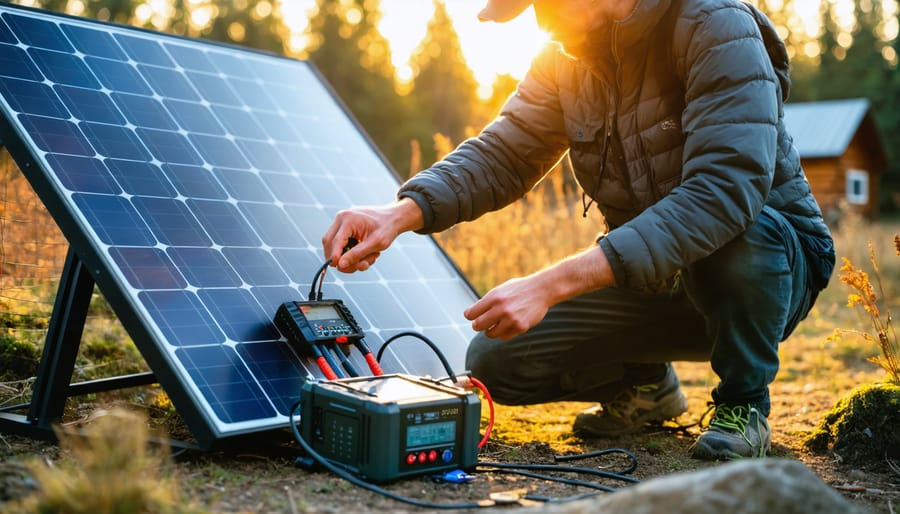How to Convert an Electric Fountain Pump into a Solar Fountain
Updated:

Mains-fed electric fountain pumps may do the job well, but they use a lot of electric energy. Particularly if they run 24/7. A cheaper, and certainly greener solution, is to convert an electric fountain pump into solar power.
Garden fountains are perennial favorite water features in many a garden nowadays. Their visual appeal is obvious and the gentle sound of flowing water adds great ambiance to any garden setting. The downside to this otherwise idyllic situation is the amount of electric energy they consume.
One of the most cost-effective methods of addressing this is to replace the AC motor with a more efficient solar model. If that is not feasible, it is still possible to rig the existing AC pump to run on solar power to save electricity.
Let’s consider the options.
AC vs Solar Fountain Pumps
Let’s look at the core differences between standard fountain pumps and solar fountain pumps.
The Differences
In most cases, a conventional water fountain setup runs on 120 volt AC (alternating current) mains grid power. A solar water fountain pump runs on the same power only supplied by a solar setup.
The Solar Panel Setup Safety Factor
Typically, an AC pump on a water fountain will either plug into an AC socket near the fountain or into a more distant power source. Either way, you will have high voltage pumps, cables, and connections running through the garden and in proximity to water.
A solar system can be located close to the fountain with a very short high voltage cable run.
The Running Cost Factor
AC-powered electric motors are notorious power guzzlers. Although installing a solar pump may initially be costly, they are far more efficient in the long run. The running cost savings would offset the initial outlay fairly quickly. And there are additional potential benefits to going solar that we’ll discuss later.
Converting an Electric Fountain Pump into a Solar Fountain
If you want to convert an electric fountain pump to solar power, there will be no need to trash the old pump. You can still run the old fountain pump on solar power.
The Solar Fountain Conversion Principle at Work
Essentially, a solar setup for an existing AC pump motor will comprise the following:
- A solar panel
- A charge controller
- A battery or batteries
- An inverter (120volt output)
- A step-down transformer for low voltage AC pumps
The Solar System in Overview
- The solar panels collect solar radiation from the sun and convert it to a low voltage electrical output.
- The charge controller serves as an interface between the solar panel and the electrical storage elements of the system. It ensures that the batteries charge safely and correctly. It also prevents that stored electrical potential from “trickling” back to the panel during the hours of darkness.
- The batteries are the primary storage element in a solar system. They hold the electrical charge generated by the solar panel for later use.
- The inverter converts the low voltage electrical potential stored in the batteries to high-voltage AC power.
Specifying Your Solar Fountain System
110/120-volt pumps
Using the components listed above a 110/120-volt solar power water fountain pump layout will look similar to Fig 1 below.

- Solar panel A produces low voltage DC output
- That output feeds to the charge controller B.
- The controller manages the panel inputs and ensures that battery C charges correctly.
- The battery feeds the low voltage charge to the inverter D. It converts the low voltage DC to a high voltage AC output which, via the water fountain pump wire, is used to drive the water fountain pump.
Low Voltage Pumps
- If you are using a low voltage AC fountain pump, you would have to insert an appropriate step-down transformer (E).
Working Out the Specs for the Solar Fountain System
As most water electric pumps for a water fountain are generally small, this is usually fairly simple. The primary concern is ensuring the inverter can drive a load equal to or exceeding your pump wattage.
The Benefits of Going Big
When converting your old pump to solar, don’t fear going big. An over-capacity solar setup is actually an excellent thing. It will allow you to tie other solar-powered landscaping features into a single power source adding value to the system.
If you have the capacity you can also add features to the solar setup that will save water and electricity. For example, you can get into implementing environmentally friendly practices by hooking up a solar water pump to water plants.
The Wrap-up
It doesn’t take a stretch of the imagination to appreciate the benefits of converting an AC-powered fountain into a solar one. The results are lowered running costs, increased safety, and the additional benefit of a solar electric source in the garden.
If you have any advice or questions regarding converting a conventional fountain into a solar one, please post them in the comments section below.










